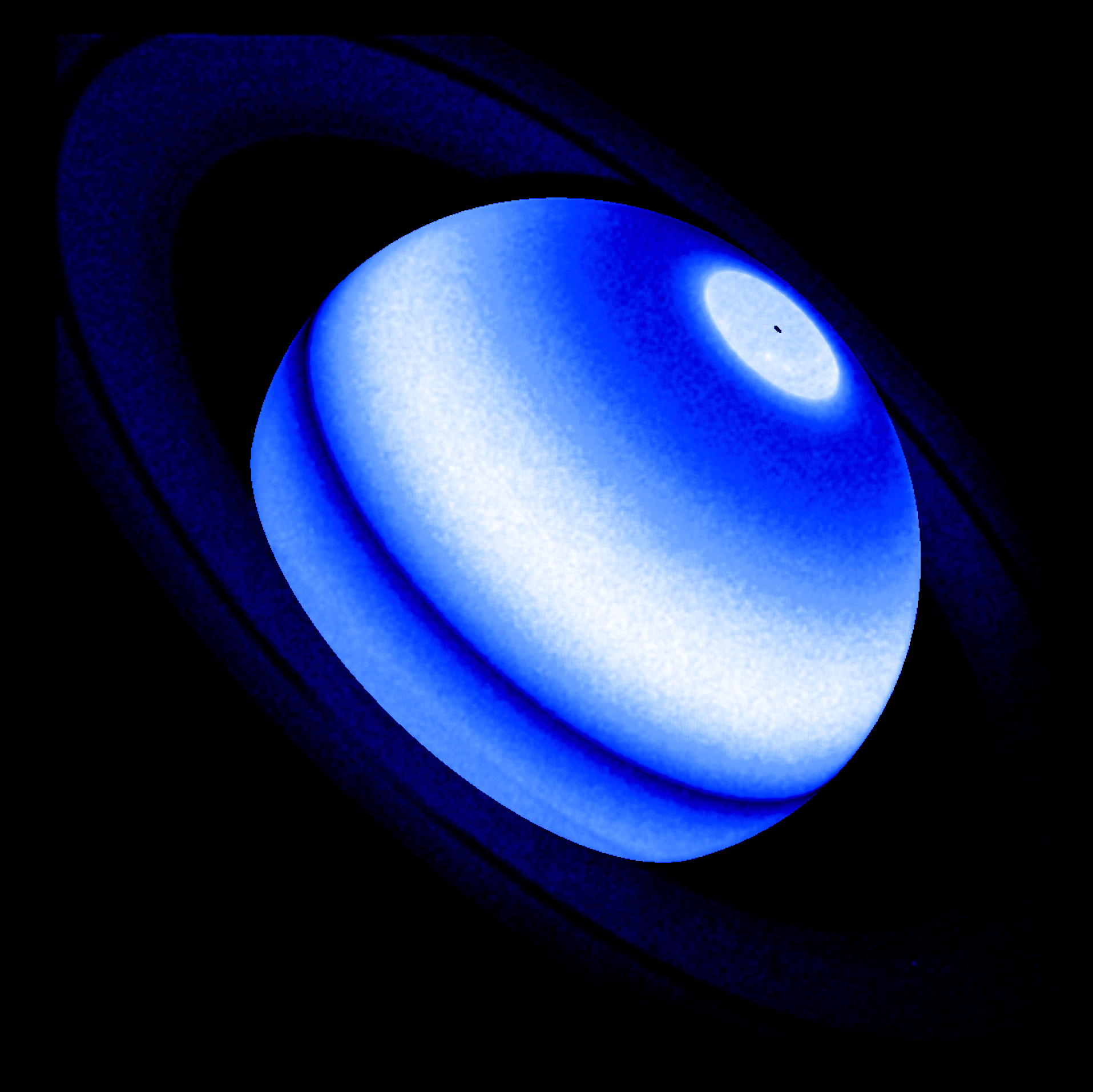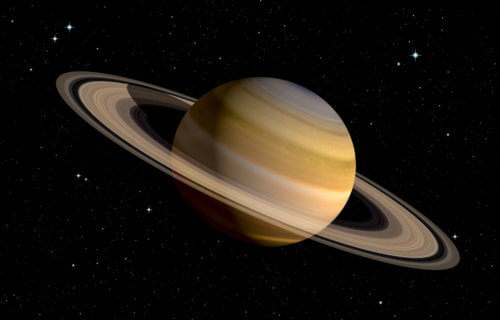GREENBELT, Md. — Saturn’s rings are iconic — but they’ve apparently been doing something to the planet that scientists never expected. A new study finds that these famous rings are actually heating Saturn’s atmosphere. Interestingly, a team from NASA says it’s something astronomers have never seen before in this solar system.
“The secret has been hiding in plain view for 40 years. But it took the insight of a veteran astronomer to pull it all together within a year, using observations of Saturn from NASA’s Hubble Space Telescope and retired Cassini probe, in addition to the Voyager 1 and 2 spacecraft and the retired International Ultraviolet Explorer mission,” a NASA spokesperson explains in a statement.
Researchers say this unexpected interaction between Saturn and its rings could potentially provide scientists with a tool for predicting whether other planets in deep space have glorious Saturn-like ring as well. The new report finds that the telltale evidence is an excess of ultraviolet radiation, appearing as a spectral line of hot hydrogen in Saturn’s atmosphere.
NASA researchers add that the bump in radiation means that something is contaminating the planet’s upper atmosphere and heating it up from the outside. Astronomers believe the most feasible explanation is that icy ring particles raining down on Saturn is heating up the atmosphere. This may be the result of impacts by micrometeorites, solar wind particle bombardment, solar ultraviolet radiation, or electromagnetic forces picking up electrically charged dust.
The pull of Saturn’s gravitational field makes all of this possible, dragging these particles down into the planet.

Scientists say this was a complete surprise
When NASA’s Cassini probe plunged into Saturn’s atmosphere at the end of its mission in 2017, researchers note it measured the atmospheric constituents — confirming that particles are constantly falling from the planet’s rings.
“Though the slow disintegration of the rings is well known, its influence on the atomic hydrogen of the planet is a surprise. From the Cassini probe, we already knew about the rings’ influence. However, we knew nothing about the atomic hydrogen content,” says study author Lotfi Ben-Jaffel of the Institute of Astrophysics in Paris and the Lunar & Planetary Laboratory, University of Arizona.
“Everything is driven by ring particles cascading into the atmosphere at specific latitudes. They modify the upper atmosphere, changing the composition. And then you also have collisional processes with atmospheric gasses that are probably heating the atmosphere at a specific altitude.”
Scientists studied Saturn missions dating back to the 1970s
Ben-Jaffel’s discovery required archival ultraviolet-light (UV) observations gathered together from four space missions studying Saturn. This includes observations from the two NASA Voyager probes which passed by Saturn in the 1980s. At the time, astronomers dismissed the excess UV measurements as noise in the old detectors.
The Cassini mission, which arrived at Saturn in 2004, also collected UV data on the atmosphere over several years. The Hubble Space Telescope and the International Ultraviolet Explorer, which launched in 1978, also collected data on the sixth planet from the Sun. Since that time, there have been lingering questions about whether all the data was really revealing a true phenomenon on Saturn.
NASA says the key to assembling the jigsaw puzzle came in Ben-Jaffel’s decision to use measurements from Hubble’s Space Telescope Imaging Spectrograph (STIS). Its precision observations of Saturn helped to calibrate the old UV data from all four space missions observing Saturn. The researcher compared the STIS UV observations of Saturn to the distribution of light from multiple space missions and instruments.
“When everything was calibrated, we saw clearly that the spectra are consistent across all the missions. This was possible because we have the same reference point, from Hubble, on the rate of transfer of energy from the atmosphere as measured over decades,” Ben-Jaffel says. “It was really a surprise for me. I just plotted the different light distribution data together, and then I realized, wow – it’s the same.”
Don’t blame the Sun for warming up Saturn
Four decades of UV data cover multiple solar cycles and help astronomers study the Sun’s seasonal effects on Saturn. By bringing all the diverse data together and calibrating it, Ben-Jaffel found that there is no difference to the level of UV radiation.
“At any time, at any position on the planet, we can follow the UV level of radiation,” Ben-Jaffel continues.
This points to the steady “ice rain” from Saturn’s rings as the best explanation.
“We are just at the beginning of this ring characterization effect on the upper atmosphere of a planet. We eventually want to have a global approach that would yield a real signature about the atmospheres on distant worlds. One of the goals of this study is to see how we can apply it to planets orbiting other stars. Call it the search for ‘exo-rings,'” the researcher concludes.
The study’s findings are published in the Planetary Science Journal.
Did you know? 15 facts about Saturn
- Saturn is the sixth planet from the sun and the second largest planet in the solar system.
- The planet is considered a gas giant because it is primarily made up of hydrogen and helium.
- While those iconic rings may be heating Saturn’s atmosphere as the study suggests, they are actually made up of ice particles and rocks.
- Saturn has at least 83 known moons, the largest of which is called Titan. Another 20 moons are awaiting confirmation and naming, according to NASA.
- Since it’s made of gas, it’s the only planet in the solar system that is less dense than water — and would float should it ever find itself in a body of water big enough to hold it.
- Saturn’s winds are the second fastest in the solar system, with speeds reaching up to 1,000 miles per hour.
- The magnetic field on Saturn is weaker than that of Earth, but it is much larger, extending beyond the orbit of its largest moon.
- Saturn has a hexagonal-shaped cloud pattern at its north pole that was first observed by the Voyager spacecraft in 1981.
- Just like Earth, Saturn has four seasons, which are caused by its tilt of 26.7 degrees. Each season, however, lasts about seven Earth years!
- The average temperature on Saturn is -178 degrees Celsius, or -285 Fahrenheit.The rings of Saturn are about 280,000 km in diameter, but only about 20 meters thick.
- Saturn’s rings were first observed by Galileo in 1610, but their true nature was not understood until the Voyager spacecraft visited Saturn in 1980 and 1981.
- The largest gap in Saturn’s rings, called the Cassini Division, is about 3,000 miles wide.
- The pressure at Saturn’s core is so great — 1,000 times greater than Earth — that hydrogen is compressed into a metallic liquid.
- The moons of Saturn are diverse, with some covered in ice, some with geysers, and others with complex surface features.
- Saturn is named after the Roman god of agriculture and wealth, and it was known to ancient civilizations as a wandering star.
South West News Service writer Dean Murray contributed to this report.


The Hubble space telescope hey?! Lol the billion dollar telescope that did not have the ability to take a picture of the earth from space? Or any space telescope or moon mission before it? Ah that one. Sure thing.
There are tens of thousands of satellites that take pictures of the Earth and Moon – many with telescopes. Look up who was Hubble – and you will realize what the telescope was made for.
You have a lot to learn.
I don’t believe a single thing that NASA says, we have been lied to all of our lives,…for instance the picture of a live mouse on the supposed lift off of a space x rocket. yeah right. Operation paperclip brought over a thousand NAZI’s to the US after the war with Germany, all they did was indoctrinate a whole bunch that in turn became NAZI’s. Shame.
Why would they need to? What was/is the mission objective[s] of each? Your statement is the same as stating, cars are useless because they can’t dig holes.
The article quotes one scientist as saying, “The slow disintegration of the rings is well known…” In an industry that often uses the speed of light as a unit of time, how slow is “slow?” Is there another process by which the rings material is being created and replaced? Or is this the early signs of a crisis that requires the involvement of terrified Scandinavian school children?
they don’t use the speed off light as a unit of time. a light lear, or the light-time unit is to define distance ( the distance light travels in that unit of time)
Thanks for the clarification, Robert. So I guess you don’t have an answer to my actual question?
So Saturn suffers from climate change! Who knew?
We need new taxes to address it.
We are observing pre-ICE AGE.
Earth was a moon covered with ice and the sun was like Saturn’s moon. I recall a voyager flying by a icy moon and reporting it had Salty waters under the ice.
Therefore, it was a Little Bang when our sun ignited and scattered all moons. The moons orbiting the closest to our sun during the ignition were scattered the furthest like Pluto and Neptune. The one orbiting the furthest was Mercury.